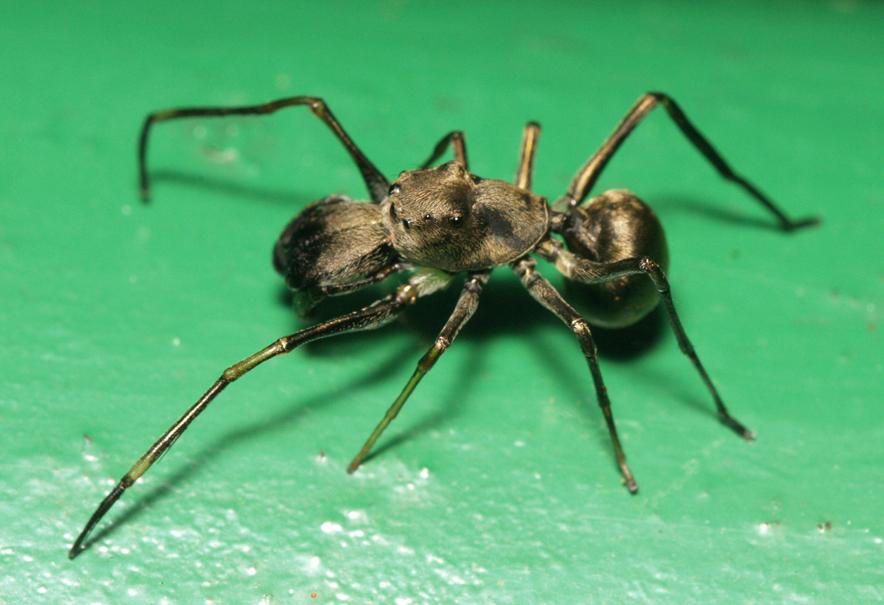
Toxeus magnus, an ant-mimicking jumping spider, nurses its young with a milk-like substance.
(Credit: Wikimedia Commons)
Like nursing baby mammals, some jumping spiders spend their earliest days feeding on a nutritious "spider milk," secreted by their mothers. What's more, spider mothers continue to care for and feed their young offspring the milk-like fluid — which contains nearly four times the protein of cow's milk — long after they're able to forage for food on their own, a new studyfinds.
Published in the November 30 issue of Science, the newly identified and peculiar behavior of the spiders hints at the possibility that long-term milk-provisioning by mothers may be more common in the animal kingdom than previously believed.
Furthermore, the researchers found that although nursing was not critical to offspring after becoming independent, their mother's presence during their young lives greatly assured their overall health and adult survival. While nursing, the mothers maintained the nest, cleaning and repairing damage and removing tiny parasites that commonly plague invertebrate nests, as their young offspring grew.
"Traditionally, we think the tiny creatures are too small to do complex things, like extended parental care," said Zhanqi Chen, a researcher at the Xishuangbanna Tropical Botanical Garden at the Chinese Academy of Sciences and lead author of the new study. "But this spider performs similar to human beings, they could construct nests for the young, do the cleaning, feed them and care for the offspring after they were sexually mature."
"I hope that people show respect to the tiny creatures, especially the mothers," said Chen.
For many animals, the growth, development and survival of the young is wholly dependent on the food provided to them by their parents. In some species, parents hunt and gather and either bring the bounty home to their offspring or feed their young the partially digested and regurgitated remains.
Other species rely on a variety of specialized feeding strategies, including the production of their own nutritional substances such as mammalian milk. For most animals, parental food provisioning ends as soon as the offspring are able to fend for themselves. In mammals, particularly those with long lives, nursing is often associated with prolonged maternal care and may provide the opportunity for offspring to learn behaviors crucial for survival.
The intensity and duration of parental care has been thought to be a uniquely mammalian trait, Chen noted.
However, one late summer night, while observing the particularly puzzling nesting behavior of Toxeus magnus — a species of ant-mimicking jumping spider — through the dense silk of its breeding nest, Chen and his colleagues observed a juvenile spider attach and then feed from the abdomen of its mother.
Toxeus magnus is one of 14 types of jumping spiders that mimic the outward appearance of ants. The tiny spiders have a "false waist" and are covered with reflective hairs that replicate the color and shiny sheen of the segmented bodies of ants. They also behave similarly to ants, waving their front legs to look like antennae or walking around in erratic patterns. Their disguises are often so deceiving that, according to Chen, many people don't believe they are spiders, even when closely observed.
The breeding nests of ant-mimicking jumping spiders are often composed of several individual spiders — two or more adults, or an adult female and a few juveniles — which is an uncommon trait for a species such as T. magnus that is presumed not live in large colonies.
While investigating this unusual nesting behavior, the researchers discovered that spiderlings didn't leave the nest until they were three weeks old and the mothers were never seen bringing food back to the young. However, by the time the juveniles emerged from the nest, their body size had increased greatly.
Laboratory observations show the young spiderlings first drinking from tiny droplets of the milk-like substance deposited on the nest's surface and then, after a week, directly sucking the substance from the mother's egg-laying opening.
Despite being a challenge to observe — spider babies fed only at night and deep inside the web-dense nests — Chen noted that the spiderlings remained in the nest and continued to nurse on spider milk for nearly 40 days, almost two weeks after being able to forage for their own food and shortly before reaching sexual maturity.
The researchers suggest that the spider milk may have evolved from trophic eggs — unviable eggs which function as food for newborn offspring in other species of spiders. Unlike other creatures, where mothers supply the trophic eggs as a one-time investment to yet-unhatched offspring, spider milk is supplied continuously to the offspring from birth to subadult ages, and in some cases past the point of sexual maturity.
According to the authors, the results demonstrate that these maternal traits exist not only in long-living vertebrates but perhaps also in other species of spiders and invertebrates throughout the animal kingdom.
"In terms of behavior, or the mother-offspring interaction and duration of the lactation period, spider lactation is similar to mammals," said Chen.
Chen and the researchers noticed that the mothers' nursing and care also seemed important for maintaining the numbers of adult female offspring required for the optimal reproductive success of the spider. Although the mothers treated all juveniles the same until they reached subadult ages (about 40 days old), only daughters were allowed to return to the breeding nest after reaching adult sexual maturity — adult sons were attacked and thrown out of the nest if they tried to return. This behavior may prevent the effects of inbreeding amongst the siblings, an important factor in maintaining healthy populations. Removing the mother greatly reduced the number of females to males, the researchers found, which could have a wider impact on the reproductive success of the species overall.
URL: https://www.aaas.org/news/jumping-spiders-nurse-offspring-nearly-adulthood?tdsourcetag=s_pcqq_aiomsg

